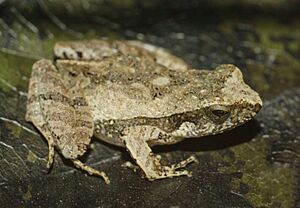Physalaemus ephippifer facts for kids
Quick facts for kids Physalaemus ephippifer |
|
|---|---|
 |
|
| Conservation status | |
| Scientific classification | |
| Synonyms | |
|
Leiuperus ephippifer Steindachner, 1864 |
The Physalaemus ephippifer is a type of frog from the Leptodactylidae family. People often call it the saddleback frog. You can find this frog in parts of central and eastern Brazil. It also lives in countries like Guyana, Suriname, and Venezuela. Scientists are not sure if it lives in French Guiana.
Contents
Meet the Saddleback Frog!
What Does It Look Like?
The saddleback frog is quite small. It grows to about 33 millimeters long. That's about the size of a large paperclip! Its body is a bit long, and its snout is pointed. This frog's ear drum, called the tympanum, is hard to see.
Its back is usually smooth. But some frogs have small bumps, like warts. It might also have a few long lines on its back. The frog's color can be light brown or reddish-brown. It often has gray marks too. A black stripe runs from its nose to its eye. This stripe then turns into a black band along its side.
The frog's belly is creamy or yellowish. Its legs have dark brown stripes. You might also see red or orange spots. These spots are usually under its arms and near its legs. Its fingers and toes do not have webs.
Where Does It Live?
The saddleback frog is a very common animal. It can live in many different places. This frog is good at adapting to changes. It even does well in areas where humans have changed the land. You can find it at the edge of forests. It also lives in open areas and places changed by people. In Suriname, it is common in grasslands called savannas. It also lives in the inner parts of the country.
How Does It Reproduce?
These frogs lay their eggs in temporary pools of water. This happens late in the wet season. The female frog creates a special foam nest. She makes a fluid from her body. Then, the male frog uses his back legs to whip it into a foam. The eggs are hidden safely inside this foam.
The eggs hatch in about three days. After two or three more days, the tiny baby frogs, called tadpoles, come out of the foam. They then grow in the water. Scientists think the foam helps protect the eggs and young tadpoles. It might even stop other animals from eating them. This includes older tadpoles of the same frog species.
Is It Safe?
The saddleback frog lives in a very large area. There are many of these frogs in total. It is a common species. This frog can live in areas changed by humans. So, it is not facing any big dangers right now. The International Union for Conservation of Nature (IUCN) checks on animals. They say this frog is of "least concern". This means it is not in danger of disappearing.


